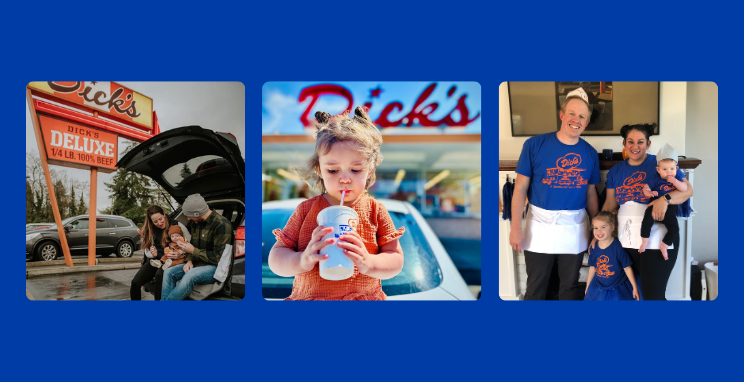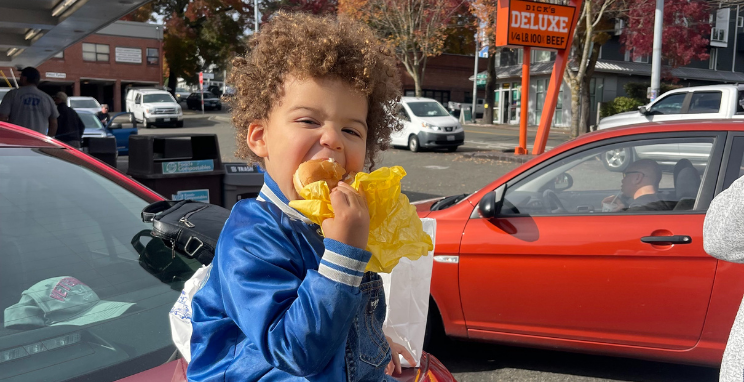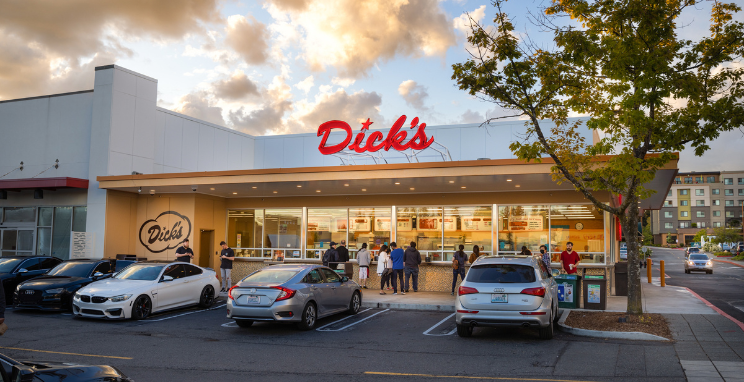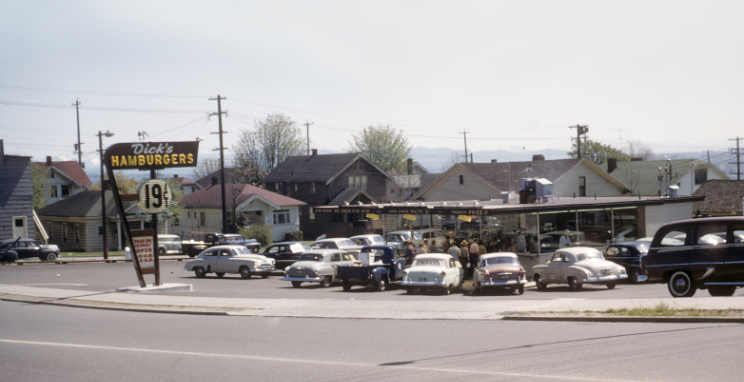“Bringing the barrier for child care down, even a little bit, is opening the door for so many more parents to be more active in the workforce. Companies want to bring in reliable, dependable employees. Parents are both of those things.”
– Hailey, Dick’s Drive-In Restaurants Crew Member
Background: Family-Owned Burger Chain Invests in Its People
In 1954, Dick Spady and partners founded Dick’s Drive-In Restaurants, a classic burger, fry and shake establishment located in Seattle, Washington, with a three-part business philosophy. “One: Make a profit. Two: Invest in employees. And three: Invest in community.” Now more than 70 years later, the business is still in the family with soon-to-be 10 restaurants located throughout the Seattle area.
While a plain hamburger at Dick’s Drive-In no longer costs 19 cents (instead it’s $2.50), the business’s founding principles ring true today. Burger chains aren’t typically known for robust compensation, but Dick’s Drive-In leads their industry in pay and benefits that include free health insurance, retirement matching, scholarships, and — since the mid-1990s — child care assistance. It’s a package that helps to pay the business back: According to Spady’s granddaughter and current president Jasmine Donovan, Dick’s Drive-In Restaurants boasts one of the lowest turnover rates in the industry.
How It Began: A Plan to Hire Parents
Around the dot-com era, Seattle was experiencing a change in the labor market, and Dick’s Drive-In was having trouble finding employees. The owners came up with a new strategy to appeal to parents, particularly mothers, with school-aged children. The concept: Take their popular educational scholarship benefit and expand it to include child care. Why hire moms and parents?
“As any mother knows, especially someone with young children at home: You know how to multitask. You know how to hustle. You don’t worry about getting dirty, right? Hard work is not a problem for you,” says Donovan.
Solution: Financial Child Care Benefit Offers Flexibility for Families
“At that time, our family took the scholarship program that was available to employees broadly, and said, ‘Instead of cutting a check to a college each quarter or semester, employees can get a check to a child care provider every month to help cover those costs.’ That’s how it all started.” Of course, restaurant operating hours and school hours aren’t the same, so employees needed a solution that would allow them to get care for their kids before and after school. Owners devised a financial child care benefit that would attract these high-quality employees by helping them pay for monthly child care costs. The model provides the flexibility for employees to work shifts that extend beyond the typical school day while also taking a hallmark employee benefit — education — and expanding it to make it meaningful to even more crew members. Various versions of the child care assistance program have been running for nearly three decades strong, and it isn’t going anywhere. Donovan states, “It’s a very well-loved benefit.”
How It Works
Dick’s Drive-In’s child care benefits for employees are based on the same model as their higher education scholarship program, which allows:
- $5,000 per year for years one and two of employment
- $9,000 per year for years three and four
- $5,000 per year thereafter, up to a lifetime benefit of $50,000 per employee
For child care, employees can use their annual allowance in monthly increments, offsetting the total monthly cost of care. Dick’s Drive-In pays the child care provider directly at the end of each month. The company also covers after school care and summer care, and provides assistance for children up to age 13.
Why more in years three and four? The educational scholarship benefit was designed to help employees afford community college tuition for two years and university tuition for two years. For ease of administration, the child care benefit follows the same structure.
Choose Your Own Provider
The program allows employees to choose their child care provider, even using funds to pay for care provided by family, friends or neighbors (also known as FFN). “Formal child care centers don’t typically offer much outside of Monday through Friday, 9 a.m. to 5 p.m.,” Donovan says. “Our employees often need access to more flexible care. And there’s a dignity component, too. While grandma might be willing to watch the kids for free, there’s at least something our employees feel like they can pay or contribute back to family members.” This type of care is often more cost effective and convenient for employees, as well.
Results: Robust Benefits Reduce Turnover
With Dick’s Drive-In’s diverse employee base and geography, the percentage of employees using the child care benefit can vary widely from location to location. But broadly, about one-third of current employees use either the scholarship or child care programs. A handful of long-time managers have used both.
Perhaps the clearest indicator that Dick’s Drive-In employees value their benefits is the restaurant’s turnover rate (or, by industry standards, more like lack thereof). At Dick’s Drive-In, most employees stay for two years. That’s an enviable statistic in the industry, where fast-food restaurants often turn over 100% of their employees (or more) annually. But at Dick’s Drive-In, the perks are paying off. Many team members who aren’t interested in building their careers in restaurant management leave Dick’s Drive-In Restaurants after a couple of years, which isn’t necessarily a bad thing. Donovan genuinely wants to help employees achieve their goals. “For most, that doesn’t mean working here forever.” Others, particularly those in management, take full advantage of the child care benefit: More than one employee has reached the $50,000 mark, and many employees have used the program to support their child care needs while advancing in their careers.
Usage Trending Up: Changing Workforce Driving Need for Child Care
In recent years, Donovan has observed that more employees are having kids while they work at Dick’s Drive-In, and she’s seeing a growing percentage of parents applying for work. It’s a trend that points to a widespread reality: Jobs at burger joints aren’t just for teenagers. “People often think that we’re primarily hiring high school students, but that’s not really true anymore. In Washington state, we have to get a special work permit for every employee who’s in high school, and there are very limited hours and other restrictions we need to comply with. While many, many years ago I’m sure a lot of employees were in the high-school to early-post-high-school-education category, that’s not really the case anymore. We have a larger percentage of our employee population made up of people who have or are having children, and child care is important.”
Donovan notes that offering child care perks has helped with recruitment, particularly recently as they’re hiring new employees to support the opening of their 10th location in summer 2025. “I definitely think offering a child care benefit has helped. It’s becoming more and more impactful over time as the demographics of our employee base are changing.”
Tracking Results
The company tracks participation and feedback through surveys to understand the impact of child care assistance and make necessary adjustments.
Challenges
Child Care Costs Still Hard to Overcome
“While I love talking about our child care offering, and our employees do very much appreciate the program, it’s still a huge investment for any of our employees to choose to have children. Unless they have access to these kinds of non-traditional care options, many employees, especially women, are going to consider leaving or be forced to leave the workforce due to the cost of child care in our area.”
Administrative Burden
Dick’s Drive-In pays employees’ preferred child care providers directly, and because they can be family, friend and neighbor (FFN) providers, it equates to more paperwork, including enrollment forms and 1099s. “Our child care benefit is very flexible, which makes it highly valuable but it is administratively burdensome to manage,” Donovan says. (Technological solutions are available, and Donovan notes that Dick’s Drive-In is exploring digital payment systems to ease some of the administration needs.)
Donovan’s Advice to Fellow Business Leaders
Consider the Trade-Offs
“Everything is a tradeoff. You may find a child care solution for workers that is less of a burden, but if it isn’t as flexible as other options, will your program help all the people that you want it to?”
Build Value for Workers and Families
“When we look at this or any other benefit that we offer, we look to add value.” Donovan explains, “The company hasn’t increased the scholarship/child care benefit beyond $5,000 per year because going higher would actually create tax complications for employees and reduce the net benefit for them.”
Be Transparent
When rolling out any new benefit, Donovan says, “Communicate often and solicit feedback often on how it’s going and how it’s perceived. Be really transparent with your people that a program may not stay forever or could change. And give yourself grace — it’s gardening, not engineering. Just because the way that you have it set up today is working well, your workforce may change and have different needs in the future. The work is never over.”
Look at the Bigger Picture
According to Donovan, when you offer child care, there’s a community impact beyond business: Dick’s Drive-In’s program supports workforce participation, especially for parents and local families, by making employment more feasible. It demonstrates a commitment to employee well-being beyond just wages. It expands child care options available locally by providing economic opportunities for smaller child care providers, which are often minority-women-owned businesses. “Offering a child care benefit is another way for us to impact our community, in addition to it being good for our employees.”
The employer views child care assistance as part of their broader philosophy, recognizing that supporting families helps both the business and the local ecosystem. As Donovan says, “If our community is thriving, our business will thrive.”
Surely, Dick Spady would be proud.





